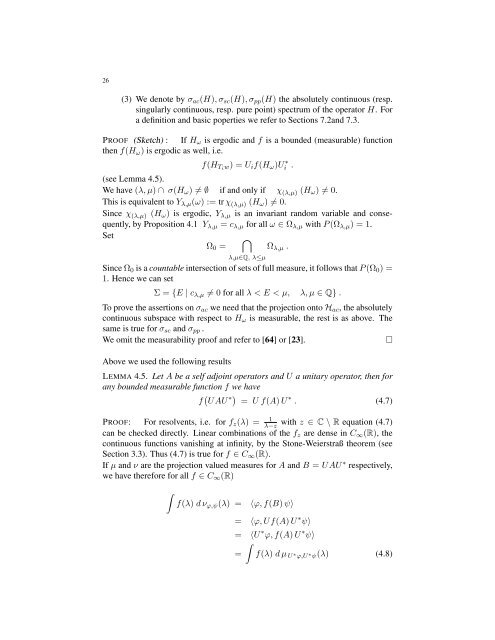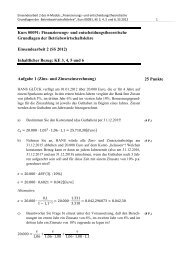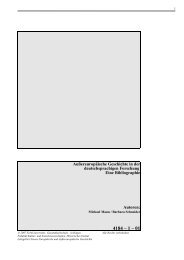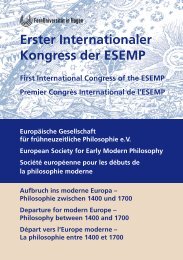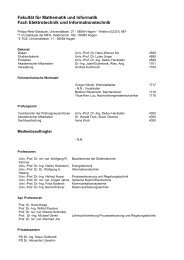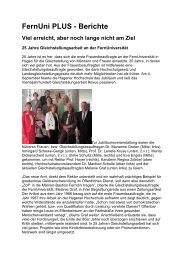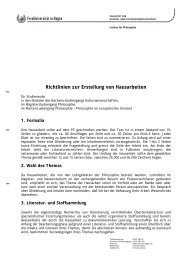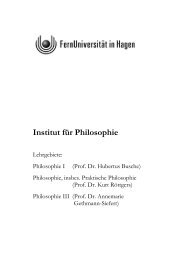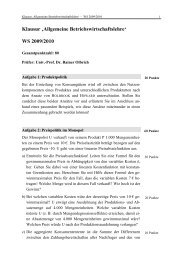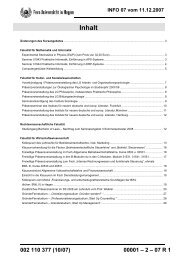An Invitation to Random Schr¨odinger operators - FernUniversität in ...
An Invitation to Random Schr¨odinger operators - FernUniversität in ...
An Invitation to Random Schr¨odinger operators - FernUniversität in ...
Create successful ePaper yourself
Turn your PDF publications into a flip-book with our unique Google optimized e-Paper software.
26<br />
(3) We denote by σ ac (H), σ sc (H), σ pp (H) the absolutely cont<strong>in</strong>uous (resp.<br />
s<strong>in</strong>gularly cont<strong>in</strong>uous, resp. pure po<strong>in</strong>t) spectrum of the opera<strong>to</strong>r H. For<br />
a def<strong>in</strong>ition and basic poperties we refer <strong>to</strong> Sections 7.2and 7.3.<br />
PROOF (Sketch) : If H ω is ergodic and f is a bounded (measurable) function<br />
then f(H ω ) is ergodic as well, i.e.<br />
f(H Ti w) = U i f(H ω )U ∗ i .<br />
(see Lemma 4.5).<br />
We have (λ, µ) ∩ σ(H ω ) ≠ ∅ if and only if χ (λ,µ) (H ω ) ≠ 0.<br />
This is equivalent <strong>to</strong> Y λ,µ (ω) := tr χ (λ,µ) (H ω ) ≠ 0.<br />
S<strong>in</strong>ce χ (λ,µ) (H ω ) is ergodic, Y λ,µ is an <strong>in</strong>variant random variable and consequently,<br />
by Proposition 4.1 Y λ,µ = c λ,µ for all ω ∈ Ω λ,µ with P (Ω λ,µ ) = 1.<br />
Set<br />
Ω 0 =<br />
⋂<br />
Ω λ,µ .<br />
λ,µ∈Q, λ≤µ<br />
S<strong>in</strong>ce Ω 0 is a countable <strong>in</strong>tersection of sets of full measure, it follows that P (Ω 0 ) =<br />
1. Hence we can set<br />
Σ = {E | c λ,µ ≠ 0 for all λ < E < µ, λ, µ ∈ Q} .<br />
To prove the assertions on σ ac we need that the projection on<strong>to</strong> H ac , the absolutely<br />
cont<strong>in</strong>uous subspace with respect <strong>to</strong> H ω is measurable, the rest is as above. The<br />
same is true for σ sc and σ pp .<br />
We omit the measurability proof and refer <strong>to</strong> [64] or [23].<br />
□<br />
Above we used the follow<strong>in</strong>g results<br />
LEMMA 4.5. Let A be a self adjo<strong>in</strong>t opera<strong>to</strong>rs and U a unitary opera<strong>to</strong>r, then for<br />
any bounded measurable function f we have<br />
f ( UAU ∗) = U f(A) U ∗ . (4.7)<br />
PROOF: For resolvents, i.e. for f z (λ) = 1<br />
λ−z<br />
with z ∈ C \ R equation (4.7)<br />
can be checked directly. L<strong>in</strong>ear comb<strong>in</strong>ations of the f z are dense <strong>in</strong> C ∞ (R), the<br />
cont<strong>in</strong>uous functions vanish<strong>in</strong>g at <strong>in</strong>f<strong>in</strong>ity, by the S<strong>to</strong>ne-Weierstraß theorem (see<br />
Section 3.3). Thus (4.7) is true for f ∈ C ∞ (R).<br />
If µ and ν are the projection valued measures for A and B = UAU ∗ respectively,<br />
we have therefore for all f ∈ C ∞ (R)<br />
∫<br />
f(λ) d ν ϕ,ψ (λ) = 〈ϕ, f(B) ψ〉<br />
= 〈ϕ, Uf(A) U ∗ ψ〉<br />
= 〈U ∗ ϕ, f(A) U ∗ ψ〉<br />
∫<br />
= f(λ) d µ U ∗ ϕ,U ∗ ψ(λ) (4.8)


